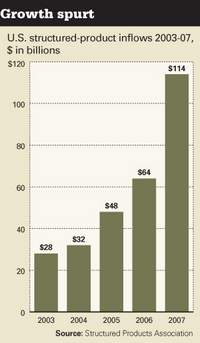Barack Obama has won the U.S. presidency with an historic 21-month march to the White House. But as the next U.S. president, his inevitable changes to the federal tax system will have implications for how efficiently structured notes produce returns -- as well as the desirability of
structured notes as an investment alternative.
In a special report being made vailable to SPA members, mtn-i's Thomas Reggiori Wilkes explores how the likely scenarios for capital gains and income tax reform may alter how notes are structured and the effect of tax treatment on the relationship between capital appreciation and coupon driven returns.
To access this report, click here.
For a special free trial subscription to mtn-i's US structured note news and data service either email us@mtn-i.com, or click here: http://www.usmtn-i.com/.
An excerpt from the report:
Trading tax treatments
Currently, structured products are taxed under a combination of capital gains and income tax codes. Non-principal protected products, and some partially protected products are subject to capital gains tax and are currently tax efficient versus their principal protected peers. Principal protected products, including FDIC insured structured certificates of deposit pay ordinary income tax on coupon payments. Regardless of whether Obama won the election, changes to tax rates will have an impact on structured notes.
“Higher tax rates are an assault on the investor class and structured products will no doubt feel the resultant pain. There may be nuanced increases or decreases on issuance of different species of structured products as tax policies may favor interest income over capital gains exposure. However, there may be very real differences in issuance levels of structured products given whether the election cuts to the left or the right,” said one broker dealer.
Thomas A. Humphreys, a tax partner at Morrison & Foerster, who specialises in the U.S. federal income taxation of capital markets transactions explains that the relationship between the two taxes is a key determinant of which instrument investors chose to invest in. "Should a higher tax environment include both higher capital gains and higher income tax rates, say from the current 15% to 20% and 35% to 40% respectively, then the relative benefits of investments that produce capital gain over those that produce ordinary income should remain the same."
"Historically there has always been a gap between the two tax rates. However, should the case be that the capital gains rate rises and moves closer to the ordinary income tax rate, the relative benefit of investments that produce capital gains decreases. There would be less of an incentive for opting for one type of investment over the other," says Humphreys.
Wednesday, November 5, 2008
Subscribe to:
Post Comments (Atom)




No comments:
Post a Comment